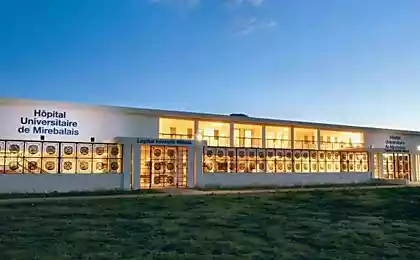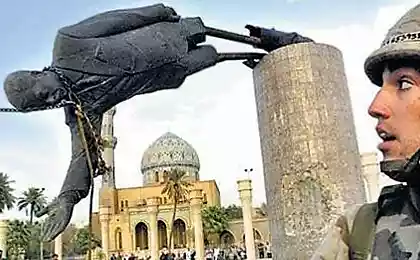2734
Interesting Facts About Haiti

Haitians were born pre-Columbian American Indians, who called Taino, "good people." Taino called their land "Aichi", which means "mountain land" - the concept has become over time, "Haiti."
More than 10% of Haitian children die before their fifth birthday.
Eighty percent of Haitians live below the poverty line and 54% live in abject poverty. Average per capita income in Haiti is $ 480 a year; For comparison, in the US it is 33 $ 550.
Because of the violence and AIDS in Haiti has the highest percentage of orphans among the countries of the Western Hemisphere. Before the 2010 earthquake in Haiti, the United Nations numbered 430,000 orphans.
About 1, 5 million people left Haiti in the early 1990s.
The average worker earns in Haiti, only 2, $ 75 a day. Due to the lack of jobs (70% do not have a permanent job) those who work there, are afraid to speak out against unfair labor organization.
Only 53% of Haitians can read and write.
National sport in Haiti is considered to be football. For the first time the country has participated in the World Cup in 1974.
Eighty percent of Haitians belong to the Roman Catholic Church, 16% - Protestants and 4% profess other religions. At the same time Christianity is often practiced Voodoo.
Pumpkins (gourds) were Haitians are so important that in 1807, President Henri Christophe (1761-1820) made them the basis of the national currency and declared all pumpkins property of the state. Today, the Haitian currency is called the "Gourde».
In the eighteenth century Saint-Domingue (Haiti) was the richest colony of the French Empire, it was known as the "Pearl of the Antilles." She became rich mainly due to the importing of slaves and a devastating impact on the environment. Currently, Haiti - one of the poorest countries in the Western Hemisphere.
In 1801, Toussaint Louverture former slave (1743-1803) took about half a million Haitian slaves against the French colonists. Their final victory was the first successful slave revolt and helped establish in Haiti the first black republic. Betrayed by the French L'Ouverture died in a French prison.
In 1803, Jean-Jacques Dessalines (1758-1806), the first ruler of Haiti, created the national flag, tattered white strip with red, white and blue of the French flag, and said that also throw up the white people out of the country. The remaining blue and red stripes symbolize the blacks and mulattos from Haiti. At the center of the flag is the coat of arms of Haiti.
Haiti - the third largest country of the West Indies; After the Dominican Republic and Cuba, which is on the first place.
Located on the top of a mountain in the north of Haiti Citadelle is the largest fortress in the Western Hemisphere.
In 2008, nearly 1, 8 million people (20% of the population) lived in Port-au-Prince, Haiti's capital.
When Columbus first saw Haiti (and the entire island of Hispaniola), he thought it was India or Asia.
After the death of Toussaint Louverture revolutionary leader in 1802, his top aide, General Jean-Jacques Dessalines, proclaimed himself Jean-Jacques The first Emperor of Haiti. He ordered the killing of most of the white population of Haiti.
In the eighteenth century, Haitians have developed a detailed genealogical tables, dividing mulattos on more than a hundred shades of black and white. They ranged from Sakatra (black 1/8) to several species Sangmel (black only on 1/16). In fact, a mulatto - a half-white, half-black man.
Only about 10% of Haitian children enrolled in primary school and continue their education in high school.
Haitians love to gamble. Their popularity - the result of the Haitian belief that so much depends on the goodwill of the gods. During voodoo ceremonies Haitians pray to the gods to reveal the winning lottery numbers.
Battle of roosters is a traditional sport in Haiti. Petukhov fed raw meat and hot peppers soaked in rum, to make them aggressive and persistent. The winner can take home $ 67, an amount greater than he could earn in a month.
Haiti - the most mountainous country of the West Indies.
Haiti - one of the few countries in the world, where almost completely destroyed original forests; kroyatsya reason in the struggle for scarce land, intensive production of charcoal, immoderate agricultural work and overgrazing wild goats. Extensive extinction of forests leads to deadly landslides and heavy flooding. Due washed away in a sea of topsoil coastline of the country is surrounded by dirty brown ring.
When in 1503 the first Spanish explorers met with resistance cacica Anacaona or "Golden Flower" (1464-1504), women's rights, in Haiti, they killed many of its people, arrested her and hanged.
The United States does not recognize the independence of the State of Haiti before 1862, although it was released in 1804.
Writer, statesman and former slave Frederick Douglass (1818-1895) was an ambassador in Haiti.
The highest point in Haiti - the peak of La Sella, its height is 8793 feet (2680 meters).
One of the islands of Haiti - Tortuga ("Turtle Island,") - was a pirate stronghold in the seventeenth century.
Haiti and Canada - the only independent country in the Americas, where French is the official state language. Although approximately 90% of Haitians use Creole as the main language. It is not considered the official language along with French until 1987.
Most modern Haitian population - descendants of Africans in ancient times brought to the West Indies as slaves.























